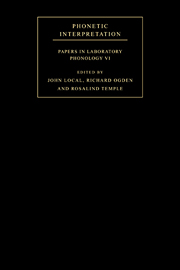Book contents
- Frontmatter
- Contents
- List of contributors
- Acknowledgements
- Introduction
- Part I Phonological representations and the lexicon
- Part II Phonetic interpretation and phrasal structure
- 6 Release the captive coda: the foot as a domain of phonetic interpretation
- 7 How many levels of phrasing? Evidence from two varieties of Italian
- 8 Domain-initial articulatory strengthening in four languages
- 9 External sandhi as gestural overlap? Counter-evidence from Sardinian
- 10 Commentary: Consonant strengthening and lengthening in various languages
- Part III Phonetic interpretation and syllable structure
- Part IV Phonology and natural speech production: tasks, contrasts and explanations
- References
- Index of names
- Index of subjects
8 - Domain-initial articulatory strengthening in four languages
Published online by Cambridge University Press: 22 September 2009
- Frontmatter
- Contents
- List of contributors
- Acknowledgements
- Introduction
- Part I Phonological representations and the lexicon
- Part II Phonetic interpretation and phrasal structure
- 6 Release the captive coda: the foot as a domain of phonetic interpretation
- 7 How many levels of phrasing? Evidence from two varieties of Italian
- 8 Domain-initial articulatory strengthening in four languages
- 9 External sandhi as gestural overlap? Counter-evidence from Sardinian
- 10 Commentary: Consonant strengthening and lengthening in various languages
- Part III Phonetic interpretation and syllable structure
- Part IV Phonology and natural speech production: tasks, contrasts and explanations
- References
- Index of names
- Index of subjects
Summary
Introduction
This paper is about one way in which prosody affects individual speech segments, with segmental phonetics showing a perhaps surprising sensitivity to higher-level linguistic structure. By prosody we mean the phrasal and tonal organisation of speech. We will show that phonetic properties of individual segments depend on their prosodic position, or position in prosodic structure.
It is well known that in a monosyllabic CVC word, the initial consonant can be pronounced differently than the final consonant, the initial consonant being longer and having greater articulatory magnitude (e.g. Byrd 1994; Keating, Wright and Zhang 1999). Some interesting recent acoustic studies have extended this line of inquiry above the syllable and word level to phrasal levels. For example, at the LabPhonII conference, Pierrehumbert and Talkin (1992) presented a study in which they used acoustic measures of breathiness to show that /h/ is more consonant-like when it is phrase-initial than when it is phrase-medial (‘The phrase boundary was found to shift articulation on both sides in a more consonantal direction’, p. 116). Similarly, the Voice Onset Time (VOT) of /t/ is longer phrase-initially. This latter result was extended by Jun (1993), who compared the VOT of Korean /ph/ in three positions: initial in a small phrase, initial in a word, medial in a word; VOT varied as shown in Figure 8.1.
Then Dilley, Shattuck-Hufnagel and Ostendorf (1996) showed that higher phrasal levels can also differ.
- Type
- Chapter
- Information
- Phonetic InterpretationPapers in Laboratory Phonology VI, pp. 145 - 163Publisher: Cambridge University PressPrint publication year: 2004
- 7
- Cited by



